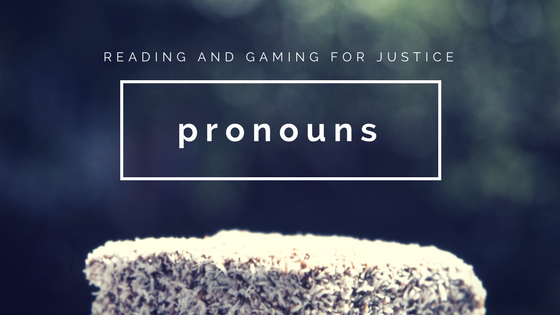
As I think about what representation for transgender and nonbinary folkx in board games, I have been thinking a lot of story driven games or games with character sheets. I have seen recently games with character sheets give players the ability to choose their character gender, within the bounds of the gender binary of course. Usually this is a double-sided character sheets – everything is the same on both sides besides the artwork. These characters are overwhelmingly (probably close to 100%) representing cisgender (meaning that their biological sex assigned at birth aligns with their gender identity and expression) men and women. While this is a step in inclusion and representation of women in gaming, this also reinforces the gender binary and marginalizes any trans or nonbinary gamers in the community.
There is an absolutely easy change here to start including trans and nonbinary gamers: include a range of gender pronouns in games.
This could be handled in a variety of ways and here are a few that I have brainstormed:
Rulebook – Yes, the rulebook. Rulebooks have examples of players… well… playing the game. Most rulebooks I have read uses the pronouns he/him/his when giving gameplay examples. A couple of recent rulebooks use the pronouns she/her/hers exclusively or alternates using he/him/his and she/her/hers. This is a great start but still within the gender binary. I am waiting for the use of other pronouns including they/them/theirs, xe/xem/xyr, or ze/hir/hirs. Having a rulebook using entirely of gender pronouns outside of the gender binary or one that uses a variety of gender pronouns will do much better in reflecting gamers who may identify outside the binary. This will also help expose cisgender gamers to different gender pronouns.
Characters – I got thinking about this topic first because I was playing Robinson Crusoe and saw the double sided player sheet. On one side of each character sheet depicts a character with all the visual markers of a cisgender man and the other depicts a character with all the physical markers of a cisgender female. Cisgender people tend to get caught up with gender markers which can lead into some terrible pitfalls and stereotypes when cis folks try to represent a person in the trans community. Gender identity can include gender markers and expression but it also is much more than that. We can start by including pronouns to use with different characters – a small change but can signal a range of gender identities. How do we ensure our trans and nonbinary characters have positive representation? Solution: Hire trans and nonbinary folkx to create characters, write bios, and illustrate character cards.
Character Bios – I think this section is very similar to the last section. A key takeaway building off of the last section is that there is no “look” to a trans or nonbinary person. In addition to artwork and illustration, a good way to communicate gender identity is through pronouns in character bios or background stories. Many games on the thematic side and some games that include a history of the world include bios or a story that relates the the characters. When games have cisgender characters, there is no in depth explanation of character’s gender identity, just the use of pronouns (he/him/his and she/her/hers) and usually some visual markers that are associated with masculinity or femininity. So here is what I propose: use nonbinary gender pronouns in a character bio – even at the top as a demographic stat (e.g., Name, Pronouns, Profession, Alignment, etc.). Even better, hire trans and nonbinary folkx to create the character and write the bio!
It may seem superficial but pronouns actually are a great habit to establish when with a person you just met or with a group you just met. This tiny change around pronouns in games will help normalize talking about pronouns and using different pronoun sets. But this extends past the actual game and goes into how we interact with each other – like I mentioned before, when meeting a new person or a group of people, no one knows each other’s pronouns. What might this look like? When introducing yourself, “Hi y’all, my name is Brendon and I use he/him pronouns.” Or in a one on one situation asking, “I want to make sure I am using the right language in our conversations – what pronouns do you want me to use for you?” Cisgender people often do not think about pronouns, assume someone’s pronouns, and put ourselves in a position where we could misgender a fellow gamer. Inclusion efforts can start small but they must start with our initiative. Try it sometime and it will begin to feel like a normal part of introducing yourself to someone else.
I’m not much of a board gamer so I wasn’t really aware of this conversation but it’s good to be informed. Great post, Brendon!
LikeLike
Posted by Zaheerah | February 22, 2018, 8:31 AM